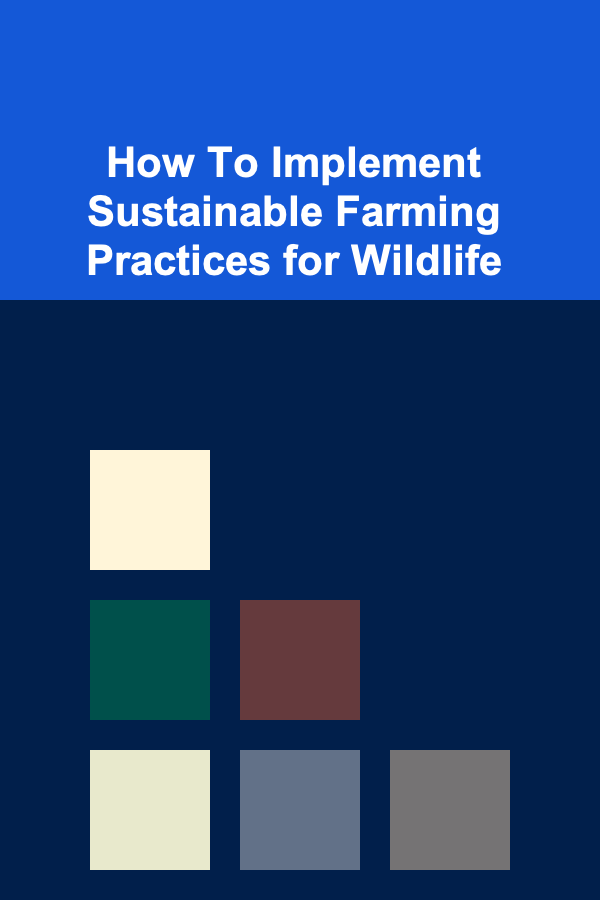
How To Implement Sustainable Farming Practices for Wildlife
ebook include PDF & Audio bundle (Micro Guide)
$12.99$11.99
Limited Time Offer! Order within the next:

Sustainable farming is a critical element in ensuring the future of our planet. As human populations continue to rise, so does the need for food production, which often comes at the expense of the environment. However, sustainable farming can help strike a balance between maintaining food security and conserving biodiversity. One of the most pressing aspects of sustainable agriculture is how farming practices can be adapted to support wildlife, whose habitats are increasingly under threat from industrial agriculture.
In this article, we will explore the importance of sustainable farming for wildlife conservation, discuss the practices that can be implemented on farms to help protect wildlife, and highlight the benefits of integrating biodiversity conservation into agricultural practices. By adopting sustainable farming methods, we can contribute to the health of ecosystems, promote biodiversity, and create a more resilient agricultural system that works in harmony with nature.
The Link Between Agriculture and Wildlife
Modern agricultural practices have drastically altered landscapes, leading to habitat destruction, fragmentation, and a decline in species diversity. As fields are cleared for monocultures, pesticide use increases, and irrigation schemes disrupt natural water cycles, wildlife populations suffer. Birds, insects, amphibians, and mammals are particularly vulnerable to the loss of their natural habitats, and many species are being driven to extinction.
Yet, agriculture does not have to be at odds with wildlife conservation. Through the implementation of sustainable farming practices, it is possible to promote biodiversity while still meeting the demands for food production. A well-designed farming system can act as a buffer between wild habitats and urban development, providing corridors for wildlife to move, breed, and feed. Additionally, sustainable farming can enhance the resilience of the land, benefiting both farmers and wildlife by maintaining healthy ecosystems that regulate water, control pests, and enrich the soil.
Key Principles of Sustainable Farming
Sustainable farming is centered around the idea of long-term agricultural productivity while minimizing negative environmental impacts. When it comes to wildlife conservation, certain principles should be considered when designing a farm that integrates nature and biodiversity.
1. Minimizing Chemical Inputs
Chemical pesticides, herbicides, and synthetic fertilizers can have a devastating impact on wildlife. Pesticides, for example, can poison beneficial insects, including pollinators such as bees and butterflies, and kill insects that serve as food for birds and amphibians. These chemicals can also contaminate soil and water, affecting other species downstream.
To mitigate these impacts, sustainable farming encourages the use of organic or natural alternatives to chemical inputs. For instance, integrated pest management (IPM) strategies combine biological, physical, and cultural methods to control pests, reducing the reliance on chemical pesticides. Organic farming practices, which avoid synthetic chemicals altogether, help to create a healthier environment for wildlife.
2. Promoting Biodiversity through Crop Diversity
Monocultures, or the practice of growing only one type of crop on a large scale, have been linked to the loss of biodiversity. These systems lack the variety of plants and animals that can thrive in a more diverse agricultural landscape. By contrast, polyculture farming, which involves growing a variety of crops in one area, creates a more varied environment that supports a broader range of species.
Crop diversity can benefit wildlife by providing a variety of habitats and food sources. For example, planting cover crops or creating agroforestry systems with trees, shrubs, and crops encourages species diversity. In addition, the use of companion planting -- planting different species of crops together that benefit each other -- can also enhance pest control and soil fertility.
3. Creating Wildlife Habitats on Farmland
One of the most effective ways to support wildlife is by integrating natural habitats into farming systems. These habitats can include wildflower strips, hedgerows, wetlands, and tree lines. These areas provide food, shelter, and nesting sites for a variety of species, from pollinators to birds and small mammals.
- Hedgerows: Hedgerows are a critical component of sustainable farming that provide vital corridors for wildlife to travel between fragmented habitats. These dense plantings of shrubs and trees can host a variety of species, from insects to birds and small mammals.
- Wildflower Strips: Wildflower strips, often planted alongside fields, can be particularly beneficial for pollinators, such as bees and butterflies. These strips provide a rich diversity of nectar and pollen, helping to support the health of pollinators that are essential for food production.
- Wetlands and Ponds: Water bodies, such as ponds, wetlands, or riparian buffers, can support a wide variety of wildlife, including amphibians, waterfowl, and insects. They also serve an important role in regulating water cycles, preventing erosion, and filtering pollutants.
By setting aside land for natural habitats and integrating these areas into the farm's landscape, farmers can significantly enhance biodiversity and provide wildlife with the resources they need to thrive.
4. Sustainable Grazing and Livestock Management
Livestock farming can also have a significant impact on wildlife if not managed properly. Overgrazing, for example, leads to soil degradation and loss of vegetation, which in turn affects wildlife that rely on those habitats. However, sustainable grazing practices can help maintain healthy ecosystems that support both livestock and wildlife.
Rotational grazing is a method that allows pastures to recover and regenerate by rotating livestock between different areas. This practice helps prevent overgrazing and allows plants to grow back, providing food for both wildlife and livestock. Additionally, the integration of livestock with crop farming in a practice known as agro-pastoralism can promote nutrient cycling and improve soil health, which benefits all species.
5. Soil Health and Erosion Control
Soil health is at the core of sustainable farming. Healthy soils are teeming with life and provide a habitat for a wide range of organisms, from earthworms to microbes. When soils are depleted through unsustainable farming practices such as monoculture, overuse of fertilizers, and tilling, the land loses its ability to support wildlife.
Conservation tillage, or no-till farming, is an essential practice in preserving soil health. By reducing the amount of soil disturbance, no-till farming helps to protect soil organisms and prevent erosion. Additionally, the use of cover crops, mulching, and crop rotations can enhance soil fertility and prevent soil degradation.
Healthy soils not only benefit wildlife by maintaining critical ecosystems but also ensure the long-term productivity of the land, allowing farmers to produce food while minimizing their environmental impact.
Benefits of Sustainable Farming for Wildlife
Implementing sustainable farming practices offers numerous benefits for wildlife, the environment, and farmers themselves. Here are some of the key advantages:
1. Increased Biodiversity
Sustainable farming encourages the presence of diverse ecosystems on farmland, supporting a wide variety of species. By providing varied habitats and food sources, farmers can help to maintain the ecological balance and protect endangered species from extinction. In turn, a diverse range of species can benefit the farm by controlling pests, pollinating crops, and enriching the soil.
2. Improved Ecosystem Services
Wildlife plays a key role in maintaining ecosystem services that are essential for agriculture. For instance, pollinators are vital for the reproduction of many crops, while predators help to control pests. Healthy soils support plant growth, and water bodies regulate hydrological cycles. By fostering healthy ecosystems through sustainable farming, farmers can increase their yields and reduce their dependency on synthetic inputs.
3. Climate Change Mitigation
Sustainable farming practices contribute to climate change mitigation by reducing carbon emissions, improving soil carbon sequestration, and enhancing resilience to extreme weather events. Practices such as agroforestry and crop diversification not only store carbon but also help reduce the impact of climate change on ecosystems and wildlife habitats.
4. Economic Resilience for Farmers
Farmers who adopt sustainable farming practices often experience greater long-term economic resilience. Healthy soils, reduced pesticide use, and enhanced biodiversity can lead to more stable crop yields and reduced costs for inputs. Moreover, consumers are increasingly demanding sustainably produced goods, opening up new market opportunities for farmers who prioritize wildlife-friendly farming practices.
Implementing Wildlife-Friendly Farming Practices: A Step-by-Step Guide
To integrate wildlife conservation into farming practices, farmers can take a number of practical steps. Here's a basic guide to getting started:
- Assess the land: Identify areas of the farm that can be set aside for wildlife habitat, such as field margins, hedgerows, or wetlands. Consider how these areas can connect with existing wildlife corridors.
- Choose suitable crops: Select crops that are suited to the local climate and ecosystem. Diversity is key---consider polycultures, agroforestry, and intercropping to create habitats for a wide range of species.
- Implement sustainable grazing: Rotate pastures, use controlled grazing systems, and integrate livestock with crop farming to enhance soil health and reduce erosion.
- Use organic farming methods: Minimize the use of synthetic pesticides and fertilizers. Adopt organic farming practices that promote soil health and protect pollinators and other beneficial wildlife.
- Create wildlife habitats: Plant wildflower strips, hedgerows, and trees, and establish ponds or wetlands where appropriate. These areas will support pollinators, birds, and other species.
- Monitor wildlife populations: Regularly assess the impact of your farming practices on wildlife. Keep track of species diversity and abundance, and make adjustments as needed.
Conclusion
Sustainable farming for wildlife is not only possible but essential for the future of agriculture and biodiversity. By incorporating wildlife-friendly practices into farming systems, we can create landscapes that are both productive and ecologically balanced. This approach supports the health of ecosystems, contributes to climate change mitigation, and benefits both farmers and wildlife.
Adopting sustainable farming practices for wildlife requires commitment and creativity, but the rewards are immense. Not only can farmers create more resilient agricultural systems, but they can also play a crucial role in preserving the planet's biodiversity for future generations. Through the integration of nature and agriculture, we can achieve a more harmonious relationship with the earth, ensuring a sustainable future for both humans and wildlife.

Beginner's Guide to Personal Finance Management
Read More
How to Invest in Index Funds vs. Individual Stocks
Read More
How to Maintain a Rental Property on a Budget
Read More
How to Set Up a Personalized Home Organization Routine
Read More
How to Turn Unused Corners of Your Home into Space-Saving Areas
Read More
Risk Manager's Guide to Financial Stability: Strategies and Practices
Read MoreOther Products

Beginner's Guide to Personal Finance Management
Read More
How to Invest in Index Funds vs. Individual Stocks
Read More
How to Maintain a Rental Property on a Budget
Read More
How to Set Up a Personalized Home Organization Routine
Read More
How to Turn Unused Corners of Your Home into Space-Saving Areas
Read More